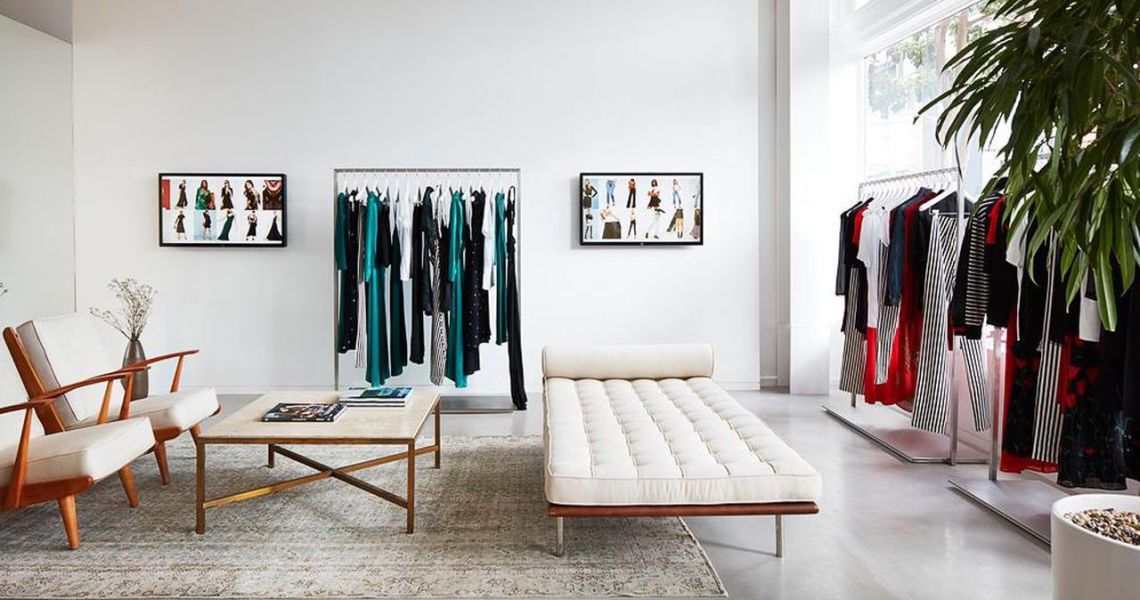Adding technology to a fitting room is by no means a new phenomenon, and yet many fashion brands are still trying to nail down the best ways to incorporate tech into these spaces.
“The challenge is that a lot of these retailers are really scared to make investments in technology, and so they start with this light, dipping-their-toe-into-it solution. You can’t just slap a tablet on the wall,” said Healey Cypher, CEO of Zivelo, a tech company that designs and creates self-service kiosks for retailers and QSR brands.
But to incorporate technology in a larger way than just a few iPads is, of course, a hefty cost for brands.
Take the “magic mirror” that retailer Rebecca Minkoff started to incorporate into its four U.S. stores in as early as 2014. (Ralph Lauren has used the technology, powered by Zivelo formerly known as Oak Labs, as well.) The mirror looks like a standard mirror but works with RFID tags to immediately identify all the items a shopper brings into the fitting room. It then allows customers to shop for other sizes and colors of the styles, see other styles that might pair well with those items and view items other customers are buying.
Its benefits can be huge for retailers — Rebecca Minkoff saw clothing sales triple the brand’s expectations for those four U.S. stores within a year of adding the mirror — but the cost per mirror for this type of technology and software can be huge, said Luke Wilwerding, senior director, North America sales at technology company Elo.
“The magic mirror concept has historically been cost-prohibitive. It becomes this New York or Park Avenue type of experience, where it’s not mainstream. I do believe it’s not a great mirror, and it’s not a great digital experience. To move mainstream, we have to commoditize using a standard mirror,” said Wilwerding.
Larger brands are finding other ways to incorporate fitting-room tech into a small sampling of stores. In January, American Eagle announced plans to put Alia Technologies’ interactive kiosks inside its flagship stores across the U.S., including Boston, Las Vegas and San Francisco. The technology allows shoppers to immediately see and request other available sizes and styles, receive product recommendations, see their cart totals and more, without ever leaving the dressing room.
“We recognize the way our customers shop is constantly evolving. We are dedicated to embracing innovative technologies that can address their needs, and we’ve been able to provide an enhanced fitting room experience,” said Dave Repp, chief technology officer at American Eagle Outfitters.
Parent company to Fabletics, TechStyle Fashion Group, is also experimenting with incorporating tech into its physical retail stores. Fabletics’ SoHo store in New York City, as well as the rest of its newer stores, have customer-facing technology, with an iPad placed outside of each fitting room and one placed inside, as well. On the screens, the store associate can see all the items the shopper has taken into the room with them, and the items also show up on the iPad inside the room.
“You can choose to see how others are wearing that item, you can choose different colors, different sizes, ask for help — all of that without hollering across a wall. It also allows us to track conversion rates in real time in the retail environment. We know if you’re happy or not happy, and we can track conversion to what’s selling and not selling in real time,” said Ron Harries, vp and head of retail at TechStyle Fashion Group.
In theory, technology like this helps retailers keep customers in the store longer and hopefully increases the amount of money they spend on a single visit. Research from Zivelo found that, with the magic mirror, brands including Rebecca Minkoff and Ralph Lauren saw, on average, a 50% increase in basket value from shoppers who used the technology. What’s more, they spent 40% less time in the fitting room, Cypher said.
In some cases, though, the technology takes away from the customer experience as it removes face-to-face interactions with store employees. Even though some of this technology is meant to cut back on wait times — allowing customers to input what they want ahead of time and find the clothes waiting for them when they enter a fitting room, for instance — customers typically still have to wait for a store associate to fulfill any additional size or style requests.
“At the end of the day, you’re actually taking away one of the reasons to go into a store, and now you got someone hiding behind a wall and putting clothes in the closet for you when they could be assisting you. These are linear PR solutions to a huge problem, which is that there needs to be some [technology] that actually makes it worthwhile to go to the store,” Cynthia Holcomb, CEO of founder of B2B preference recommendation marketing platform Prefeye.




